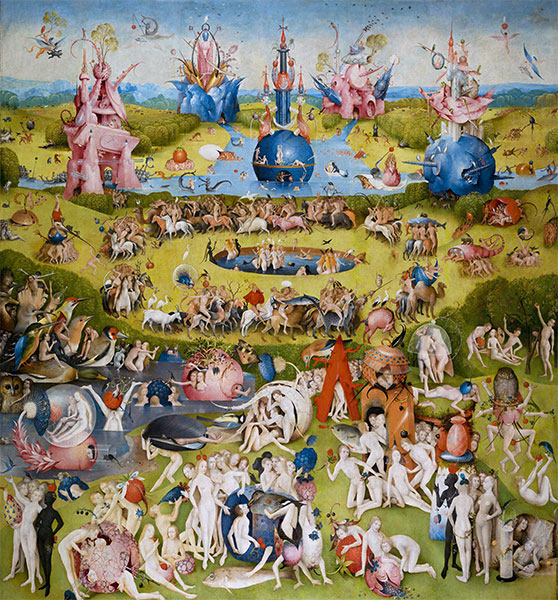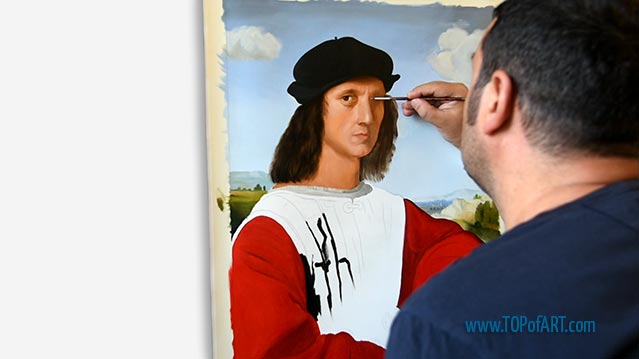The Garden of Earthly Delights, c.1490/00 Hieronymus Bosch (c.1450-1516)
Location: Prado Museum Madrid SpainOriginal Size: 183 x 171 cm
Own a museum-quality reproduction of The Garden of Earthly Delights by Hieronymus Bosch (c.1490/00), exclusively hand-painted in oils on linen canvas by European artists with academic training. Each masterpiece is created with meticulous craftsmanship, capturing the exceptional quality and authentic brushwork of the original painting.
Oil Painting Reproduction
If you want a different size than the offered
Description
Painted by European Аrtists with Academic Education
Museum Quality
+ 4 cm (1.6") Margins for Stretching
Creation Time: 8-10 Weeks
Creation Process
We create our paintings with museum quality and covering the highest academic standards. Once we get your order, it will be entirely hand-painted with oil on canvas. All the materials we use are the highest level, being totally artist graded painting materials and linen canvas.
We will add 1.6" (4 cm) additional blank canvas all over the painting for stretching.
High quality and detailing in every inch are time consuming. The reproduction of Hieronymus Bosch also needs time to dry in order to be completely ready for shipping, as this is crucial to not be damaged during transportation.
Based on the size, level of detail and complexity we need 8-10 weeks to complete the process.
In case the delivery date needs to be extended in time, or we are overloaded with requests, there will be an email sent to you sharing the new timelines of production and delivery.
TOPofART wants to remind you to keep patient, in order to get you the highest quality, being our mission to fulfill your expectations.
We not stretch and frame our oil paintings due to several reasons:
Painting reproduction is a high quality expensive product, which we cannot risk to damage by sending it being stretched.
Also, there are postal restrictions, regarding the size of the shipment.
Additionally, due to the dimensions of the stretched canvas, the shipment price may exceed the price of the product itself.
You can stretch and frame your painting in your local frame-shop.
Delivery
Once the painting The Garden of Earthly Delights is ready and dry, it will be shipped to your delivery address. The canvas will be rolled-up in a secure postal tube.
We offer free shipping as well as paid express transportation services.
After adding your artwork to the shopping cart, you will be able to check the delivery price using the Estimate Shipping and Tax tool.
Museum Quality
The paintings we create are only of museum quality. Our academy graduated artists will never allow a compromise in the quality and detail of the ordered painting. TOPofART do not work, and will never allow ourselves to work with low quality studios from the Far East. We are based in Europe, and quality is our highest priority.
Additional Information
The colors are, at first glance, almost pastoral - a serene, almost idyllic landscape dominated by lush greens, blues, and soft pinks. But don't be fooled. There’s a twisted carnival of excess playing out in this so-called paradise. Everywhere you look, there’s something off-kilter. Naked figures frolic with animals and fruit in bizarrely sensuous ways. Giant berries, birds, and fish pop out as if Bosch was running wild with the laws of scale. You’ve got horses riding in circles, couples entwined in impossible contortions, and oversized, alien-like structures rising in the background. The glowing pink towers and shimmering, unnatural blues give the whole thing a nightmarish glow, almost like a fairy tale gone wrong.
Bosch’s technique is meticulous, almost maniacally so. The fine detailing of figures and natural elements is surreal, offering an absurd amount of visual information. His composition is nothing short of chaotic brilliance - figures and symbols swirl in a hypnotic spiral of indulgence, each element pulling your eyes in a different direction. Yet, everything feels oddly connected, as if all this madness is bound by some invisible thread of moral warning. It’s a painting that invites you to look closer, but at the same time, it laughs at you for even trying to make sense of it.
1 Reviews
5.00 Overall rating
This exceptional triptych is of crucial importance in correcting the usual picture of Bosch as a participant in the supernatural and the apocalyptic, in magic, alchemy and witches, in a time of bloody persecutions and trials. According to the out-moded view, in depicting enigmas and hieroglyphs, monsters and hybrids, dreamlike juxtapositions and symbols of sin and folly, Bosch is the painter of the demoniac, of obsession with sexuality and all that perturbs the religious spirit. A great mass of literary interpretations has diverted attention from Bosch's style and prevented an authentic understanding of his work. If he sometimes intentionally loaded his art with representational functions (Christ Carrying the Cross in Ghent, where he rivals Metsys in the adoption of Leonardo's grotesques), he based them on a rigorous and 'rational' tendency to be found in Holland (Geertgen and followers, Master of the Virgo inter Virgines, etc.), and which is also connected with such French painters as Fouquet, the Master of Moulins, the Master of St. Sebastian. Furthermore, in working from the earliest Flemish masters, Bosch does not hesitate to learn from Jan van Eyck, the founding father of the tradition. There is no doubt that a fanciful intellectual climate, rich in myth and passions carried to the point of nightmare visions, gave Bosch the opportunity to insert a marvellously free kind of painting into an established idea of subject matter. The persistence of the Temptation of St. Anthony theme is better explained by the wealth of fabulous detail permitted by the legend, than by any veneration of the saint in the master's native town of's Hertogenbosch. And his inventive faculty was undoubtedly immense, inexhaustible, to such an extent that it has favoured an almost exclusive attention to his ever-surprising subject matter and reduced his work to a matter of anecdotes.
The forms of his paintings, however, are not all obscure or sunk in details; their clarity is carried to a point of transparent lucidity: the 'demoniac' is manifest in every supposedly tortured image. The transformation of the real into an autonomous vision is not accomplished through an iconography of the impossible, but first of all in terms of pictorial expression. The three parts of this triptych are unified by three large concentric perspective rings (to which the terrestrial globe on the outside of the wings corresponds), while below, the rigorous distribution of details along diagonals (and the corresponding perspective levels) makes possible an extremely dense elaboration of subordinate motifs, without dispersion or lapses in the narrative or illustration. All the individual forms are marked by a geometric purity which, in close correspondence with the rhythm, unifies each part; the part in turn is spontaneously linked with and flows into the next, with a continual transformation that is also an internal form of the highest coherency. A close rein is kept on the imaginative representation, and its reduction to basic, controlled modules. Accordingly, it is hard to know how to speak of the anxious, the troubled and the diabolic before these joyous sequences, in places somewhat ironical or frivolous, where life is seen in its infinite guises, in its hidden connections, in its possible transformations and passages, in all its impetus that pervades every object, animate or not. Here the nature of man is exalted; it is not an orgiastic vision, but lyrically contained by a style that personalizes and harmonizes every part of the work, which is meant to be read attentively throughout its clearly marked courses, where movement and rest alternate, and everything is of equal intensity, from the choral ensemble to the most secret detail. Bosch himself may be present in the vision, in a presumed self-portrait.

